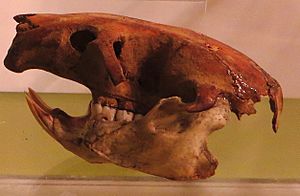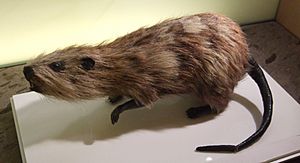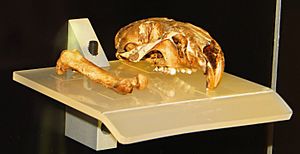Tenerife giant rat facts for kids
Quick facts for kids Tenerife giant ratTemporal range: Late Pleistocene
|
|
|---|---|
 |
|
| Skull housed in Museo de la Naturaleza y el Hombre in Santa Cruz de Tenerife. | |
| Scientific classification | |
| Genus: |
Canariomys
|
| Species: |
bravoi
|
The Tenerife giant rat (Canariomys bravoi) was a very large type of rat that used to live only on the island of Tenerife. Tenerife is the biggest of the Canary Islands in Spain. Scientists have found many bones of these rats during digs. Most of these bones are from a time called the Pleistocene period. Some finds have been dated to the later part of the Pleistocene. Sadly, this amazing animal is now extinct.
Contents
Discovering the Giant Rat
Scientists have found fossil bones of the Tenerife giant rat almost everywhere on the island. They often find them in caves or old volcanic tunnels. These rat bones are sometimes found with bones of other large animals, like the giant lizards called Gallotia goliath. Many bones were found in a place called Buenavista del Norte in the northwest of Tenerife.
When Were They Discovered?
The fossils of these giant rats are from the Pleistocene epoch, a long time ago. The first fossils were found by a naturalist named Telesforo Bravo. The rat's scientific name, Canariomys bravoi, comes from his name. Two biologists, Crusafont-Pairó and Petter, were the first to officially describe this giant rat in 1964.
Why Did They Disappear?
The Tenerife giant rat, along with other unique animals on the islands, became extinct because of human activities. The first people to live on the Canary Islands were the Guanches. They arrived around 1000 BC. When they came, they brought animals like feral cats with them. These cats likely hunted the giant rats, which helped lead to their extinction.
Where to See Remains Today
Today, you can see fossil skulls and bones of the Tenerife giant rat. There are also realistic models of the animal. You can find them at the Museo de la Naturaleza y el Hombre (Museum of Nature and Man) in Santa Cruz de Tenerife. Another giant rat from the Canary Islands was the Canariomys tamarani.
What the Giant Rat Looked Like
This species was a very big rat. It weighed about 1 kilogram (2.2 pounds) or more. Its skull could be up to seven centimeters (2.8 inches) long. Including its tail, the rat was over 1.14 meters (3 feet 9 inches) long. This made it the largest rat in its family, at least in the Canary Islands.
How It Moved
A scientific study from 2012 compared Canariomys bravoi to modern tree-dwelling rodents. One example is Phloeomys cumingi, a giant rat from the island of Luzon in the Philippines. The study showed that the Tenerife giant rat had claws that were similar on both its front and back paws. Its back legs were also longer than its front legs. This suggests it could move in different ways, like an animal that lives in trees but also on the ground. Scientists believe Canariomys bravoi was a strong and muscular rodent. It could move well on different surfaces, from the ground to the trees. It probably also had good digging skills.
See also
 In Spanish: Rata gigante de Tenerife para niños
In Spanish: Rata gigante de Tenerife para niños
- List of African animals extinct in the Holocene
- List of extinct animals of Europe
- Island gigantism



